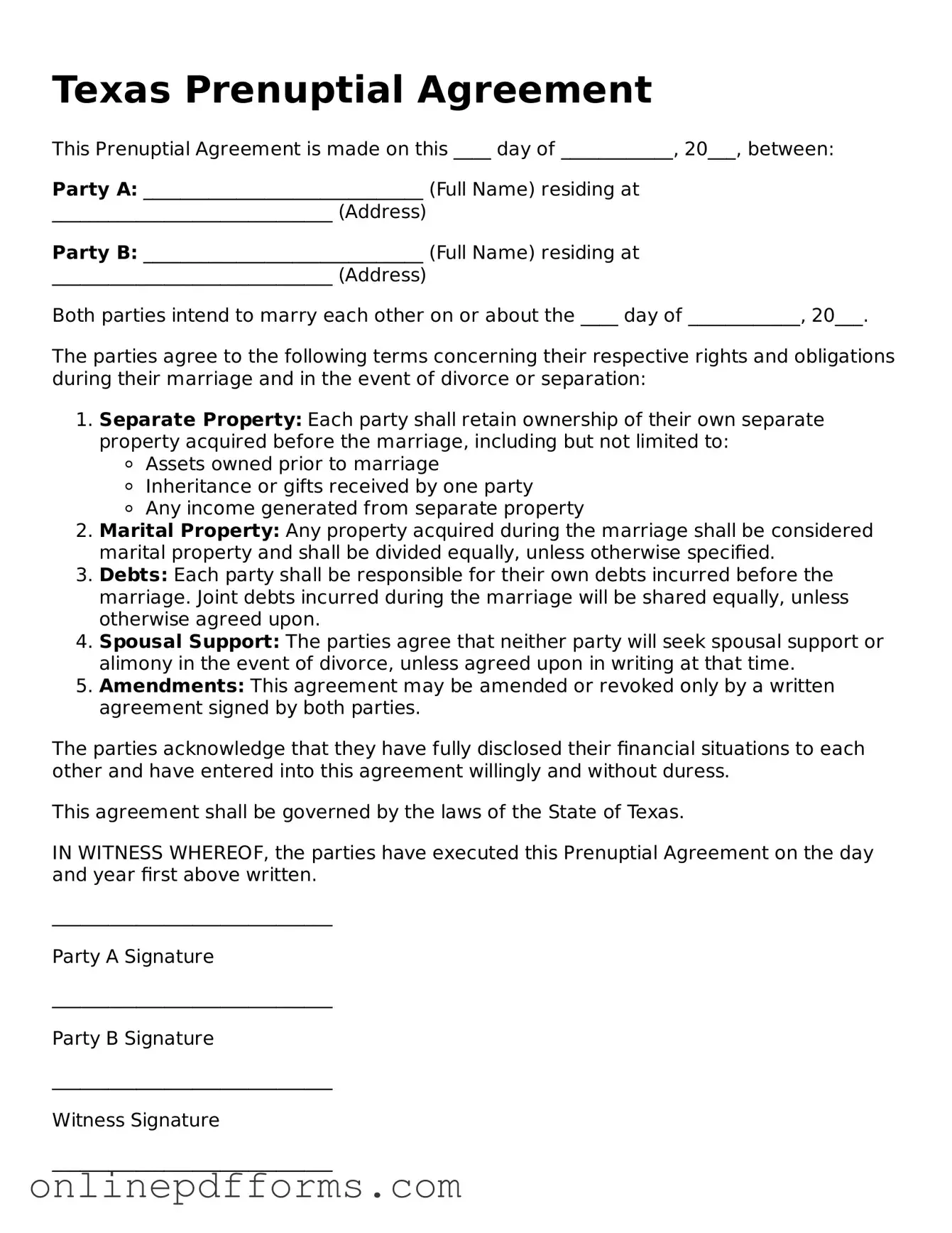The Texas Prenuptial Agreement form shares similarities with a Postnuptial Agreement. Both documents serve to outline the financial and property rights of spouses. While a prenuptial agreement is established before marriage, a postnuptial agreement is created after the couple has already tied the knot. Both agreements can address issues such as asset division, debt responsibility, and spousal support, providing clarity and security for both parties in the event of divorce or separation.
Another document that resembles the Texas Prenuptial Agreement is a Cohabitation Agreement. This type of agreement is designed for couples who live together but are not married. Like prenuptial agreements, cohabitation agreements can specify how property will be divided and how debts will be managed. They offer similar protections and can help prevent disputes by clearly outlining each partner's rights and responsibilities during the relationship and in the event of a breakup.
The Texas Prenuptial Agreement also bears resemblance to a Separation Agreement. This document is typically created when a couple decides to separate but not yet divorce. It outlines the terms of the separation, including asset division and child custody arrangements. Both agreements aim to provide a clear framework for the couple's financial responsibilities and rights, minimizing conflict during difficult transitions.
A Marital Settlement Agreement is another document that aligns closely with a prenuptial agreement. Often created during divorce proceedings, this document outlines how the couple will divide their assets and debts. While a prenuptial agreement is proactive, a marital settlement agreement is reactive, addressing issues after the marriage has ended. Both documents seek to provide a fair resolution and protect the interests of both parties.
The Texas Prenuptial Agreement is similar to a Trust Agreement as well. A trust agreement is used to manage assets for the benefit of specific individuals or entities. Both documents can specify how assets will be handled, but a trust agreement often involves the management of assets during a person’s lifetime and after their death, while a prenuptial agreement focuses on asset division in the context of marriage and divorce.
A Business Partnership Agreement also shares some characteristics with a prenuptial agreement. This document outlines the roles, responsibilities, and profit-sharing arrangements between business partners. Similar to how a prenuptial agreement protects individual assets in a marriage, a partnership agreement protects the interests of each partner in a business venture, ensuring that all parties understand their rights and obligations.
The Texas Prenuptial Agreement can be compared to a Will. Both documents address the distribution of assets, but they serve different purposes. A will dictates how a person’s assets will be distributed upon their death, while a prenuptial agreement focuses on asset division during marriage or divorce. Both documents are essential for ensuring that individuals’ wishes are honored regarding their property and financial matters.
When dealing with the sale of a trailer, it is essential to have the necessary legal documentation in place to protect both the buyer and seller. In Missouri, the Trailer Bill of Sale serves this purpose by recording important details of the transaction. For those looking for standardized documents, various resources are available, including Auto Bill of Sale Forms, which can help facilitate a smooth transfer of ownership and ensure compliance with state laws.
Another related document is a Financial Disclosure Statement. This statement is often used in divorce proceedings to provide a clear picture of each spouse's financial situation. Similar to a prenuptial agreement, it requires full transparency regarding assets and debts. Both documents aim to ensure that all parties are informed about financial matters, which can facilitate fair negotiations and settlements.
Lastly, the Texas Prenuptial Agreement has similarities with a Child Custody Agreement. While the primary focus of a prenuptial agreement is on financial matters, a child custody agreement addresses the care and upbringing of children in the event of a divorce. Both agreements aim to provide structure and clarity, helping to prevent disputes and ensuring that the needs of all parties involved are considered.
